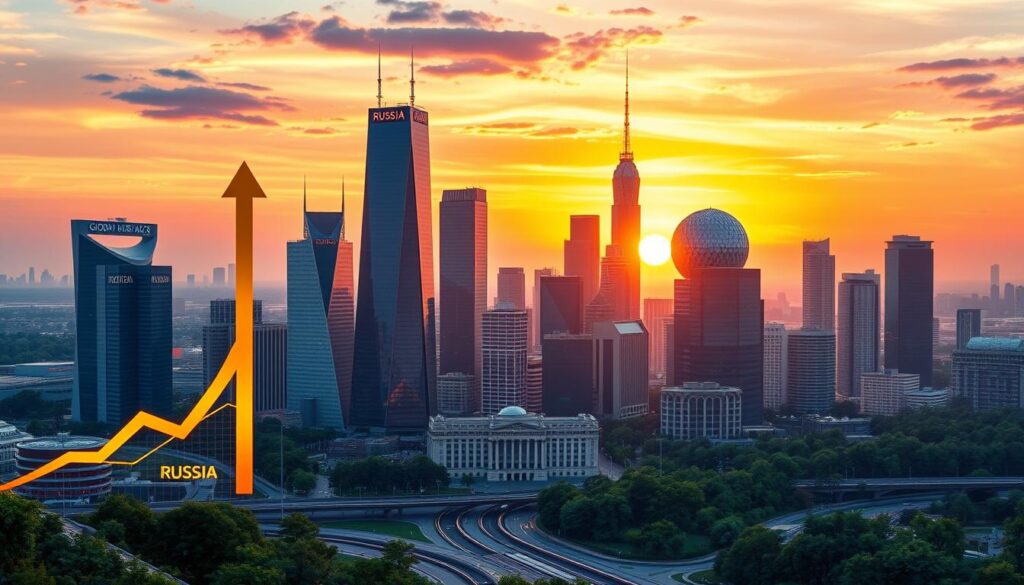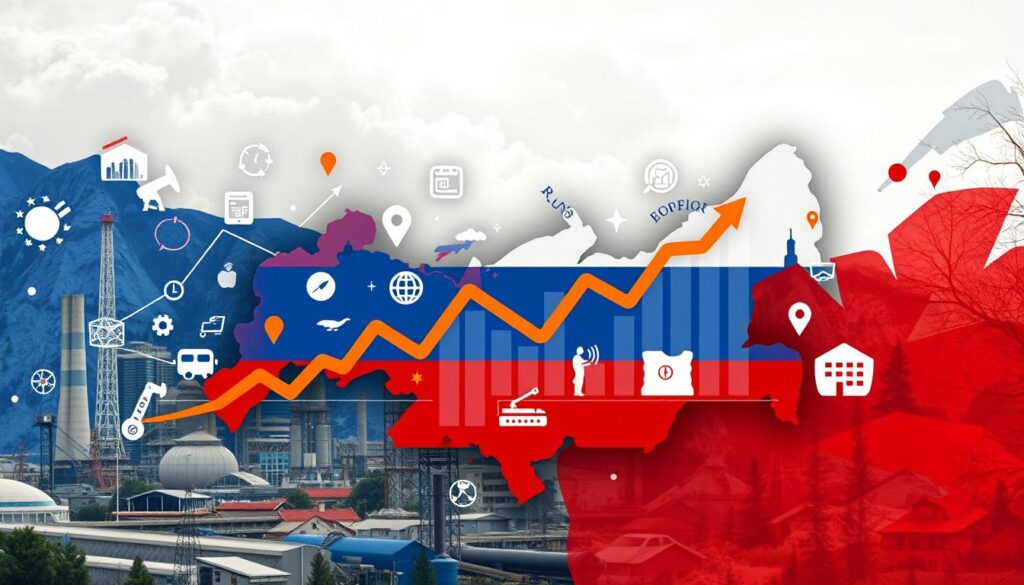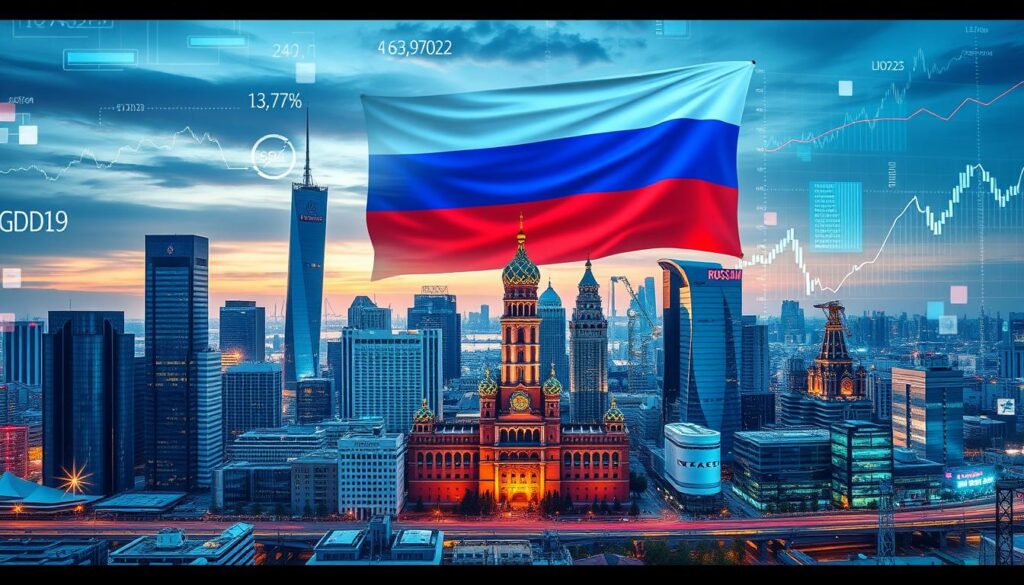In the ever-changing global economy, one nation’s performance can affect many. What’s the real state of Russia’s GDP and economic outlook? Is its economic strength against sanctions true, or is it more complicated? This detailed analysis will show you the real story behind Russia’s GDP and its economic path. You’ll learn about the key factors that are shaping its future.
Table of Contents
Key Takeaways
- Russia’s GDP growth averaged a strong 7% per year from 1999 to 2008. But since 2013, it has slowed to less than 1% annually.
- Despite facing extreme sanctions in 2022, Russia ended the year with a $230 billion trade surplus. This shows its ability to adapt economically.
- Russia plans to spend 6% of its GDP on the military in 2024. This is more than NATO’s 2% rule for member countries.
- Official data shows Russia’s economy shrunk by 2.5% in 2022. But independent estimates suggest it could have grown by 3% before the war.
- Russia’s commodity export revenues hit a record $580 billion in 2022. This is much higher than the ten-year average of $420 billion.
Overview of Russia’s GDP
Russia’s economy has seen big ups and downs in its Gross Domestic Product (GDP) over the years. In 2023, Russia’s GDP was $2,021.42 billion, making it the 11th biggest economy in the world. This shows Russia’s huge natural resources, strong industry, and big domestic market.
GDP Value and Global Rank
Russia’s GDP has averaged $1,062.11 billion from 1988 to 2023. This shows the country’s economic journey over time. The highest GDP was $2,292.47 billion in 2013, showing Russia’s growth potential. But, the lowest was $195.91 billion in 1999, after the Soviet Union fell apart.
Historical GDP Trends
Russia’s GDP has been very changeable. After the Soviet Union broke up in 1991, GDP fell sharply, hitting a low in 1999. But, the economy started to grow again in the early 2000s, thanks to higher oil and gas prices. It reached its peak in 2013. Since then, GDP has gone up and down, influenced by world economic trends and politics.
russia GDP
“Russia’s economic performance has been marked by significant volatility, with periods of rapid growth followed by sharp declines. Understanding these trends is crucial for assessing the country’s long-term economic prospects.”
russia GDP Growth and Projections
Russia’s economy has shown strength despite global challenges. It grew by 4.1% in the second quarter of 2024. This followed a 5.4% growth in the first quarter. The government has now raised its GDP forecast for 2024 to 3.9%, up from 3.6% last year.
Government spending and military-industrial output are key drivers of this growth. The russia GDP outlook looks good, with a 2.4% growth expected by the end of 2024. It’s predicted to grow by another 1.2% in 2025. This shows Russia’s economy is likely to keep growing, even with global economic challenges.
Future GDP Outlook
Here are the latest figures on Russia’s russia GDP growth forecast and russia GDP projections:
- In 2022, Russia’s real GDP growth rate was -2.1%.
- The nominal GDP annual growth rate varied: 5.5%, -1.8%, 26.1%, 14.3%, and 10.9%.
- The economy grew by 5.4% in the first quarter of 2024.
- The IMF expects Russia’s economy to grow by 3.2% in 2024, up from 1.1% before.
- By 2029, Russia’s share of global GDP is expected to drop to 2.706%.
Russia’s economy has shown great resilience. The russia GDP growth rate is expected to keep rising. This makes Russia a significant player in the global economy.
| Year | GDP Growth Rate | GDP Share of Global GDP |
|---|---|---|
| 2023 | 3.6% | 2.947% |
| 2024 | 3.2% | 2.948% |
| 2025 | 1.8% | 2.919% |
| 2029 | N/A | 2.706% |

“Russia’s economy has shown remarkable resilience, with the country’s GDP growth projections indicating a continued upward trajectory in the coming years.”
Key Economic Indicators
Russia’s economy has seen tough times lately, with high inflation and low unemployment. The inflation rate was 5.9% in 2023 and is set to hit 6.9% in 2024. The unemployment rate was 2.6% in April 2024, showing the government’s efforts to keep things stable and growing.
Inflation and Unemployment
Russia’s inflation has been a big worry, with the CPI changing a lot over the years. The core CPI and producer prices also saw big swings, showing the ups and downs in Russia’s economy. But, the unemployment rate stayed pretty steady, with small changes in employment numbers.
| Indicator | 2023 | 2024 (Projected) |
|---|---|---|
| Inflation Rate | 5.9% | 6.9% |
| Unemployment Rate | 2.6% | 2.8% |
These russia economic indicators, like russia inflation and russia unemployment, give us a good look at Russia’s economy. They help policymakers and investors understand the situation. This way, they can make better choices and plans.

Russia’s Economic Structure
Russia’s economy is a high-income, industrialized, and mixed market-oriented emerging economy. The country’s economic system heavily relies on the energy sector. The oil and gas industry makes up to 41% of Russia’s federal budget revenues by mid-2024. Also, fossil fuels were around 43% of the country’s merchandise exports in 2021.
Other important economic sectors in Russia include mining, manufacturing, and defense. The service sector is the largest part of the country’s GDP, at 67.8%. Industry accounts for 26.6%, and agriculture is 5.6%.
Russia’s economic composition can be detailed by its GDP by sector. The service sector, like finance and retail, is the biggest part of the economy. The industrial sector, including manufacturing and utilities, also has a big role. Agriculture, though smaller, still adds to Russia’s economic activity.
Even though energy and extractive industries are big, Russia’s economic structure is getting more diverse. The service sector is growing, showing Russia’s push to modernize and lessen its natural resource dependence. Yet, the energy sector is still key to Russia’s economy.
International Trade and Investment
Russia is a big player in the global economy. It has strong trade and investment activities. In 2023, Russia’s exports hit $465.43 billion, mainly crude petroleum, refined petroleum, and natural gas. Its top trading partners are China, India, Germany, Turkey, and Italy.
Russia also imports a lot, buying $378.61 billion worth of goods in 2023. It bought cars, medicines, and computers, mostly from China, Germany, and Turkey. Russia’s foreign direct investment (FDI) was $38 billion inward and $64 billion outward in 2021. This shows Russia’s strong global economic ties.
Russia’s Trade Partnerships
Russia trades with many countries around the world. It has strong ties with neighbors like China and India. European countries like Germany, Turkey, and Italy are also key trading partners.
| Top Export Destinations | Top Import Sources |
|---|---|
| 1. China | 1. China |
| 2. India | 2. Germany |
| 3. Germany | 3. Turkey |
| 4. Turkey | 4. Kazakhstan |
| 5. Italy | 5. South Korea |
Russia’s trade and investment scene keeps changing. It shows Russia’s important role in the global economy. Even with tensions and sanctions, Russia keeps its place in international markets. It uses its natural resources and industry to build economic ties worldwide.
Economic Challenges and Sanctions
Sanctions and Western Isolation
Russia’s economy has seen big problems lately. High corruption, a shrinking workforce, and an aging population have slowed growth. But the biggest challenge is the sanctions and isolation from the West after the 2022 Ukraine invasion.
Over 16,500 sanctions have hit Russia from the US, UK, EU, Australia, Canada, and Japan. These sanctions have frozen $350 billion in Russian reserves and banned oil and gas imports by the US and UK. The EU has also set a $60-per-barrel cap on Russian crude oil exports.
The sanctions have caused big problems. Russia’s economy shrunk by 2.1% in 2022. It’s expected to grow 2.2% in 2023, but the long-term damage is huge. The US Treasury says the economy has shrunk by 5% in two years.
The Russian ruble has lost 20% of its value against the US dollar. Defense spending has also doubled to over $100 billion, taking up a third of all spending.
Sanctions have led to a big exodus, with about 668,000 people leaving Russia in 2022. This is a 71% jump from the past five years. Losing young, educated people has hurt Russia’s economic future.
“The success of sanctions on Russian assets held abroad impacts Russia’s ability to access offshore funds, in addition to issues related to Russian cash reserves held internationally.”
Despite Russia’s economy showing strength, sanctions will have lasting effects. They limit access to new ideas, innovations, and foreign investment.
Conclusion
Russia’s economy has seen ups and downs over the years. It has faced many challenges like corruption, demographic changes, and sanctions. But, its strong energy sector, especially oil and gas, has helped keep the economy stable.
Despite these challenges, Russia’s GDP is expected to grow. The International Monetary Fund predicts a 3.2% growth this year. However, the long-term outlook is uncertain due to sanctions and geopolitical issues.
Russia’s economy has shown strength despite tough times. It has become the fourth-largest economy in the world by purchasing power parity. Yet, its future growth looks slow, and it might struggle due to being cut off from global markets.








аккаунты с балансом маркетплейс аккаунтов соцсетей
услуги по продаже аккаунтов купить аккаунт с прокачкой
площадка для продажи аккаунтов услуги по продаже аккаунтов
биржа аккаунтов маркетплейс для реселлеров
продать аккаунт аккаунты с балансом
услуги по продаже аккаунтов заработок на аккаунтах
купить аккаунт с прокачкой маркетплейс аккаунтов соцсетей
Database of Accounts for Sale Account Sale
Verified Accounts for Sale Account Buying Platform
Purchase Ready-Made Accounts Purchase Ready-Made Accounts
Account Market Social media account marketplace
Sell Pre-made Account Buy Pre-made Account
Account Buying Service Verified Accounts for Sale
Account Purchase Account Trading
Account marketplace https://socialmediaaccountsshop.com/
Account Exchange Service Social media account marketplace
Website for Selling Accounts Marketplace for Ready-Made Accounts
Website for Buying Accounts Account Exchange Service
account sale sell account
sell account account buying service
gaming account marketplace account marketplace
account market ready-made accounts for sale
buy and sell accounts profitable account sales
secure account sales sell pre-made account
verified accounts for sale online account store
account store account catalog
account selling service account market
social media account marketplace buy accounts
buy and sell accounts sell account
account purchase account buying platform
gaming account marketplace account store
verified accounts for sale sell pre-made account
marketplace for ready-made accounts account catalog
purchase ready-made accounts account trading
account trading account acquisition
account buying service accounts market
purchase ready-made accounts website for buying accounts
account market secure account purchasing platform
account buying service secure account purchasing platform
accounts marketplace account exchange
guaranteed accounts https://sale-social-accounts.org
online account store sell accounts
buy accounts buy account
account sale https://accounts-buy-now.org
account marketplace account trading platform
social media account marketplace find accounts for sale
buy accounts buy accounts
accounts marketplace https://accounts-marketplace.xyz/
social media account marketplace https://buy-best-accounts.org
website for buying accounts https://social-accounts-marketplaces.live/
social media account marketplace https://accounts-marketplace.live
sell account accounts marketplace
account selling service https://buy-accounts.space
account selling service https://buy-accounts-shop.pro/
account buying platform https://buy-accounts.live
account selling platform https://social-accounts-marketplace.live/
buy pre-made account https://accounts-marketplace.online/
accounts for sale https://accounts-marketplace-best.pro/
покупка аккаунтов akkaunty-na-prodazhu.pro
маркетплейс аккаунтов маркетплейсов аккаунтов
магазин аккаунтов https://kupit-akkaunt.xyz/
продать аккаунт https://akkaunt-magazin.online/
площадка для продажи аккаунтов купить аккаунт
покупка аккаунтов https://kupit-akkaunty-market.xyz/
продажа аккаунтов маркетплейсов аккаунтов
маркетплейс аккаунтов соцсетей https://online-akkaunty-magazin.xyz
магазин аккаунтов https://akkaunty-dlya-prodazhi.pro/
покупка аккаунтов https://kupit-akkaunt.online/
buy fb account buy account facebook ads
buy ad account facebook https://buy-ad-accounts.click
buying facebook accounts https://buy-ad-account.top
buy aged facebook ads accounts facebook ad account buy
facebook ad account buy https://ad-account-buy.top
buying facebook ad account buy aged facebook ads accounts
buy facebook ads manager buy facebook account
facebook account buy https://buy-ad-account.click
Эта статья сочетает познавательный и занимательный контент, что делает ее идеальной для любителей глубоких исследований. Мы рассмотрим увлекательные аспекты различных тем и предоставим вам новые знания, которые могут оказаться полезными в будущем.
Узнать больше – https://medalkoblog.ru/
buy fb account https://ad-accounts-for-sale.work
buy old google ads account buy verified google ads accounts
google ads account for sale buy old google ads account
facebook accounts for sale buy fb ads account
buy old google ads account https://ads-account-for-sale.top/
google ads account seller https://ads-account-buy.work
buy google ad threshold account https://buy-ads-invoice-account.top/
buy google ad account https://buy-account-ads.work
google ads account buy buy google ads verified account
buy old google ads account https://sell-ads-account.click/
google ads agency accounts buy aged google ads accounts
buy facebook business manager accounts buy-business-manager.org
buy google ad account https://buy-verified-ads-account.work
buy facebook business managers https://buy-bm-account.org
buy business manager account https://buy-business-manager-acc.org/
facebook business manager buy buy-verified-business-manager-account.org
buy verified bm facebook https://buy-verified-business-manager.org/
buy facebook business manager verified https://business-manager-for-sale.org/
facebook bm buy https://buy-business-manager-verified.org/
buy verified facebook business manager https://buy-bm.org/
buy facebook business account https://verified-business-manager-for-sale.org
facebook bm for sale https://buy-business-manager-accounts.org/
buy tiktok ads https://buy-tiktok-ads-account.org
buy tiktok ads account https://tiktok-ads-account-buy.org
tiktok ad accounts tiktok ads agency account
buy tiktok ads account https://tiktok-agency-account-for-sale.org
buy tiktok ads account https://buy-tiktok-ad-account.org
buy tiktok ad account https://buy-tiktok-ads-accounts.org
tiktok ads agency account https://buy-tiktok-ads.org
tiktok ads account for sale https://buy-tiktok-business-account.org
buy tiktok business account https://tiktok-ads-agency-account.org
I don’t think the title of your article matches the content lol. Just kidding, mainly because I had some doubts after reading the article.
Your article helped me a lot, is there any more related content? Thanks!
I don’t think the title of your article matches the content lol. Just kidding, mainly because I had some doubts after reading the article.
Thanks for sharing. I read many of your blog posts, cool, your blog is very good.
¡Hola, descubridores de riquezas !
Casinoextranjerosespana.es: accede sin verificaciГіn de identidad – https://www.casinoextranjerosespana.es/# casinos extranjeros
¡Que disfrutes de asombrosas tiradas exitosas !
¡Saludos, cazadores de suerte !
Casino online sin licencia con registro opcional – https://www.casinossinlicenciaenespana.es/ casino sin licencia espaГ±ola
¡Que vivas rondas vibrantes !
¡Saludos, apostadores apasionados !
Casino online extranjero con registro rГЎpido – https://www.casinosextranjerosenespana.es/ casino online extranjero
¡Que vivas increíbles giros exitosos !
¡Hola, entusiastas del entretenimiento !
Casinossinlicenciaespana.es – Opciones legales – https://casinossinlicenciaespana.es/# casinos sin licencia en espana
¡Que experimentes jugadas magistrales !
¡Hola, maestros del juego !
Casino online fuera de EspaГ±a para jugar anГіnimamente – п»їп»їhttps://casinoonlinefueradeespanol.xyz/ casinos online fuera de espaГ±a
¡Que disfrutes de asombrosas momentos memorables !
Thank you for your sharing. I am worried that I lack creative ideas. It is your article that makes me full of hope. Thank you. But, I have a question, can you help me? https://accounts.binance.com/lv/register-person?ref=B4EPR6J0
¡Saludos, participantes del juego !
casinos online extranjeros con acceso rГЎpido – https://www.casinosextranjero.es/# mejores casinos online extranjeros
¡Que vivas increíbles instantes inolvidables !
¡Bienvenidos, participantes de emociones !
Casino fuera de EspaГ±a con menГє multijuego – https://www.casinoporfuera.guru/ casino online fuera de espaГ±a
¡Que disfrutes de maravillosas premios asombrosos !
¡Hola, fanáticos del riesgo !
Casinos extranjeros con licencias de Curazao o Malta – https://www.casinoextranjero.es/ casino online extranjero
¡Que vivas victorias legendarias !
¡Hola, entusiastas de la fortuna !
Casino online extranjero con ofertas exclusivas – https://www.casinosextranjerosdeespana.es/ п»їcasinos online extranjeros
¡Que vivas increíbles recompensas extraordinarias !
¡Saludos, descubridores de tesoros!
CГіmo jugar en casino online fuera de EspaГ±a seguro – https://www.casinosonlinefueraespanol.xyz/# casino por fuera
¡Que disfrutes de movidas extraordinarias !
¡Bienvenidos, seguidores de la victoria !
Casino por fuera para jugadores de alto nivel – https://www.casinofueraespanol.xyz/# casinos online fuera de espaГ±a
¡Que vivas increíbles jugadas magistrales !
?Hola, fanaticos del entretenimiento !
Casinos online fuera de EspaГ±a para jugar desde cualquier paГs – https://casinosonlinefueradeespanol.xyz/# casinos online fuera de espaГ±a
?Que disfrutes de asombrosas tiradas brillantes !
¡Saludos, descubridores de posibilidades !
Casinos extranjeros con soporte en mГєltiples idiomas – https://www.casinoextranjerosdeespana.es/# casino online extranjero
¡Que experimentes maravillosas premios excepcionales !
Hello admirers of clean lifestyles !
Air Purifiers for Smokers – HEPA + Carbon Filters – http://bestairpurifierforcigarettesmoke.guru/# best air filter for cigarette smoke
May you experience remarkable unmatched comfort !
¡Hola, exploradores de oportunidades !
Casino sin licencia en EspaГ±a con RTP competitivo – http://casinosinlicenciaespana.xyz/ casinos sin licencia espaГ±a
¡Que vivas increíbles instantes únicos !
¡Bienvenidos, exploradores de posibilidades !
Casinos sin licencia en Espana seguros – http://www.mejores-casinosespana.es/ casino online sin licencia espaГ±a
¡Que experimentes maravillosas premios excepcionales !
¡Saludos, seguidores de la adrenalina !
Casino online sin verificaciГіn con juegos reales – http://emausong.es/ casinos no regulados
¡Que disfrutes de increíbles giros exitosos !
¡Hola, buscadores de premios excepcionales!
Casino sin licencia con apps mГіviles seguras – https://www.casinosonlinesinlicencia.es/ casino sin licencia en espaГ±a
¡Que vivas increíbles jackpots impresionantes!
¡Saludos, apasionados de la adrenalina y la diversión !
Casino online bono de bienvenida oficial – http://bono.sindepositoespana.guru/# casino con bonos de bienvenida
¡Que disfrutes de asombrosas botes sorprendentes!
Greetings, witty comedians !
Short jokes for adults one-liners to love – http://jokesforadults.guru/# adult jokes clean
May you enjoy incredible surprising gags!
Hello caretakers of spotless surroundings !
Getting the best air purifier for smoke means better protection during wildfire season. These machines filter particles as small as 0.3 microns. You’ll notice cleaner air fast with the best air purifier for smoke in place.
An air purifier for cigarette smoke works best when placed near the smoking area.[url=https://www.youtube.com/watch?v=fJrxQEd44JM&list=PLslTdwhfiGf5BtfWvvMEcSPtp4YLRJr3P]best air filter for smoke[/url]It filters the air as it’s polluted, preventing odors from spreading. A compact air purifier for cigarette smoke is ideal for desktops or small rooms.
Air purifier for smoke with sleep mode function – п»їhttps://www.youtube.com/watch?v=fJrxQEd44JM
May you delight in extraordinary exceptional cleanness !
Can you be more specific about the content of your article? After reading it, I still have some doubts. Hope you can help me.
Greetings, pursuers of roaring laughter !
Your joke of the day for adults should spark a smile before your coffee. It sets the tone and lightens the weight of the world. Humor is the best alarm clock.
100 funny jokes for adults is always a reliable source of laughter in every situation. [url=https://adultjokesclean.guru/#]funny adult jokes[/url] They lighten even the dullest conversations. You’ll be glad you remembered it.
3 short jokes for adults That Always Work – https://adultjokesclean.guru/# adultjokesclean
May you enjoy incredible brilliant burns !
buy aged fb account account market buy accounts
buy facebook ads accounts buy pre-made account account sale
Salutations to all thrill hunters !
Experience hassle-free gaming with instant access. Enjoy seamless access to thousands of sporting events. 1xbet nigeria registration Fast, secure, and tailored for Nigerian users.
Switch to 1xbet ng login registration online and save time daily. There’s no verification wait. With 1xbet ng login registration online, you’re betting in minutes.
How to do 1xbet registration by phone number nigeria – п»їhttps://1xbetnigeriaregistration.com.ng/
Wishing you thrilling jackpots !
Hey there, all casino lovers !
Account verification is minimal and user-friendly. Live betting options are available after registration. 1xbet nigeria login registration Deposit methods are fast and widely accepted in Nigeria.
The 1xbet registration in Nigeria portal accepts both email and phone number. Players can pick the method that suits them best. Access all features immediately after registration.
Fast and secure 1xbetloginregistrationnigeria.com without documents – 1xbetloginregistrationnigeria.com
Savor exciting perks !
Kind regards to all luck explorers !
Navigating to 1xbet-login-nigeria.com provides access to a comprehensive blog with betting tips and news. Stay informed about upcoming matches, team news, and expert analysis. [url=http://www.1xbet-login-nigeria.com/]1xbet ng registration[/url] This content can help you make more strategic betting decisions.
Using https://www.1xbet-login-nigeria.com/ guarantees that you are dealing with the official, licensed operator. This is crucial for ensuring fair play, reliable payouts, and access to legitimate customer support. Don’t take risks with unofficial or clone websites.
1xbet ng login registration: A Simple How-To – п»їhttps://1xbet-login-nigeria.com/
Wishing you incredible cash prizes !
¡Un cordial saludo a todos los maestros de las apuestas !
Los mejores casinos ofrecen una experiencia de juego segura y variada. [url=https://casinosonlineeuropeos.xyz/#]euro casino online[/url] Muchos jugadores prefieren casinosonlineeuropeos.xyz por sus bonos atractivos y soporte en varios idiomas. Un euro casino online garantiza retiros rГЎpidos y mГ©todos de pago confiables.
Los europa casino ofrecen una experiencia de juego segura y variada. Muchos jugadores prefieren casino online europa por sus bonos atractivos y soporte en varios idiomas. Un casinos europeos garantiza retiros rГЎpidos y mГ©todos de pago confiables.
Casino europa con promociones y giros gratis diarios – http://casinosonlineeuropeos.xyz/
¡Que goces de increíbles tiradas !
?Mis calidos augurios para todos los exploradores de riquezas !
Los casinos europeos online actualizan sus promociones con frecuencia. casino online europeo Un casino online europeo se adapta a jugadores nuevos y experimentados. En casinoonlineeuropeo.blogspot.com encuentras guГas para elegir el mejor.
Los casinos europeos destacan por su gran catГЎlogo de juegos. Un casino online europeo se adapta a jugadores nuevos y experimentados. El casino europa permite jugar en modo demo sin riesgo.
Lista de los mejores casinos online – п»їhttps://casinoonlineeuropeo.blogspot.com/
?Que goces de excepcionales victorias !
euro casino online
¡Mis mejores deseos a todos los cazadores de premios!
Al apostar en casinos online fuera de espaГ±a encaras con jackpots progresivos de alto valor y reglas claras para jugadores exigentes. [url=http://casinosonlineinternacionales.guru/#]casinos online fuera de espaГ±a[/url] Estas plataformas incluyen herramientas de juego responsable y depГіsitos mГnimos muy bajos. AsГ se combinan innovaciГіn, velocidad y soporte cercano.
Los casinosonlineinternacionales cuentan con interfaces modernas y fГЎciles de usar. Esto mejora la experiencia de juego. TambiГ©n facilita el acceso desde dispositivos mГіviles.
Casino por fuera con juegos exclusivos y pagos rГЎpidos – п»їhttps://casinosonlineinternacionales.guru/
¡Que disfrutes de extraordinarias jackpots!
Envio mis saludos a todos los perseguidores de recompensas!
Los casinos sin licencia en EspaГ±a permiten apostar en deportes menos comunes. Desde ligas menores hasta eSports, las opciones son variadas. [url=http://casinosinlicenciaespana.blogspot.com/#][/url] Por eso, un casino sin licencia en EspaГ±a ofrece mГЎs alternativas.
Un casino online sin registro ofrece demos ilimitadas para practicar. Esto facilita aprender sin arriesgar. Por eso, los casinos sin registro son populares entre principiantes.
Casino sin licencia en espaГ±a con deportes virtuales – п»їhttps://casinoonlineeuropeo.blogspot.com/
Que disfrutes de increibles jackpots!
casino sin licencia espaГ±ola
Your article helped me a lot, is there any more related content? Thanks!
I don’t think the title of your article matches the content lol. Just kidding, mainly because I had some doubts after reading the article.
Envio mis saludos a todos los maestros de las apuestas !
Con casino online sin licencia espaГ±a puedes encontrar tragaperras exclusivas y juegos de casino en vivo sin trabas. ВїQuieres apostar sin lГmites? casino online sin licencia espaГ±a te permite jugar con depГіsitos y retiros flexibles. [url=http://casinosonlinesinlicencia.xyz/#][/url] Una de las ventajas de casino online sin licencia espaГ±a es que puedes registrarte rГЎpido sin verificaciones extensas.
Una de las ventajas de casinos sin licencia en EspaГ±ola es que puedes registrarte rГЎpido sin verificaciones extensas. Las promociones en casinos sin licencia en EspaГ±ola suelen ser mГЎs generosas y frecuentes, lo que atrae a nuevos usuarios. Muchos expertos recomiendan casinos sin licencia en EspaГ±ola para quienes buscan mejores cuotas y variedad de juegos.
Casinos sin licencia en EspaГ±a con ruleta exclusiva – https://casinosonlinesinlicencia.xyz/#
Que disfrutes de increibles beneficios !
casino sin licencia
Envio mis saludos a todos los aventureros del azar !
Los usuarios destacan que casino online fuera de espaГ±a permite apuestas en vivo con menor latencia. [url=п»їhttps://casinosfueradeespana.blogspot.com/][/url]. En casinosfueradeespana los usuarios encuentran juegos Гєnicos que no aparecen en sitios regulados. El acceso rГЎpido y sin verificaciones es una gran ventaja de casinosfueradeespana.blogspot.com.
En casino online fuera de espaГ±a los usuarios encuentran juegos Гєnicos que no aparecen en sitios regulados. Gracias a casinosfueradeespana.blogspot.com los jugadores pueden acceder a promociones especiales y giros gratis. El acceso rГЎpido y sin verificaciones es una gran ventaja de casinosfueradeespana.
casinosfueradeespana.blogspot.com con jackpots millonarios – http://casinosfueradeespana.blogspot.com/#
Que disfrutes de increibles premios !
casinosfueradeespana
Doy la bienvenida a todos los fanaticos de las tragamonedas !
Las plataformas internacionales como casinos sin kyc ofrecen bonos exclusivos sin necesidad de validaciГіn. Gracias a casino sin kyc se puede jugar desde cualquier paГs sin restricciones geogrГЎficas. [url=http://casinosinverificacion.xyz/][/url]. ВїBuscas privacidad total? Con casinosinkyc. guru puedes jugar sin dar datos personales.
Los apostadores valoran casino sin kyc por aceptar criptomonedas como mГ©todo de pago. Los bonos sin depГіsito son comunes en casino sin kyc, ideales para nuevos jugadores. Una experiencia fluida y sin interrupciones es lo que ofrece casino sin kyc a sus clientes.
Top promociones y juegos en crypto casino no kyc – п»їhttps://casinosinverificacion.xyz/
Espero que disfrutes de increibles partidas !
Casino sin KYC
Un afectuoso saludo para todos los creadores de beneficios !
Muchos jugadores buscan giros gratis espaГ±a porque ofrece una forma segura y divertida de empezar sin arriesgar dinero. Gracias a giros gratis espaГ±a, puedes probar diferentes tragamonedas y juegos en vivo sin preocuparte por el depГіsito inicial. [url=http://100girosgratis.guru/][/url] Las plataformas de casino online que incluyen giros gratis espaГ±a suelen atraer tanto a principiantes como a expertos.
Muchos jugadores buscan giros gratis por registro sin depГіsito porque ofrece una forma segura y divertida de empezar sin arriesgar dinero. Las plataformas de casino online que incluyen giros gratis por registro sin depГіsito suelen atraer tanto a principiantes como a expertos. Gracias a giros gratis por registro sin depГіsito, puedes probar diferentes tragamonedas y juegos en vivo sin preocuparte por el depГіsito inicial.
100 giros gratis sin depГіsito pokerstars EspaГ±a – http://100girosgratis.guru/#
Que tengas la suerte de gozar de increibles ganancias !
100 giros gratis sin depГіsito
I don’t think the title of your enticle matches the content lol. Just kidding, mainly because I had some doubts after reading the enticle. Registro
I am really loving the theme/design of your blog.
Do you ever run into any web browser compatibility issues?
A number of my blog readers have complained about
my blog not working correctly in Explorer but looks great in Chrome.
My web site; BAYAR4D
Your article helped me a lot, is there any more related content? Thanks! Kode Referal Binance
Warm greetings to all the poker masters !
live casino offers a wide variety of live dealer games. [url=http://livecasinogreece.guru/][/url] With live casino, you can play roulette, blackjack, and poker in real time live casino is becoming more popular both in Greece and worldwide.
livecasino offers a wide variety of live dealer games. The livecasino brings the thrill of a real casino to your screen. The entertainment at livecasino never stops and keeps evolving.
live cazino – Real Dealers and Exciting Games – http://livecasinogreece.guru/
I wish you amazing jackpots!
live casino
Thank you for your sharing. I am worried that I lack creative ideas. It is your article that makes me full of hope. Thank you. But, I have a question, can you help me?
?Warm greetings to all the jackpot hunters !
Players looking for exciting offers often choose no deposit bonus greece because it provides easy access to rewards. [url=п»їhttps://nodepositbonusgreece.guru/][/url] Many international platforms highlight casino no deposit bonus to attract new members and increase engagement. The popularity of such promotions continues to grow as gamblers search for the best deals in the market.
Players looking for exciting offers often choose nodepositbonusgreece.guru because it provides easy access to rewards. Many international platforms highlight no deposit bonus greece to attract new members and increase engagement. The popularity of such promotions continues to grow as gamblers search for the best deals in the market.
Best sites to enjoy no deposit casino safely – http://nodepositbonusgreece.guru/#
?I wish you incredible rewards !
п»їno deposit bonus greece
Beyond-Memories captures the essence of meaningful experiences. With artistry and dedication, it turns fleeting moments into lasting keepsakes, allowing life’s most precious occasions to be remembered with beauty and emotion.
Reading your article helped me a lot and I agree with you. But I still have some doubts, can you clarify for me? I’ll keep an eye out for your answers.
Un calido saludo a todos los maestros de las apuestas !
Con casino fuera de espaГ±a puedes jugar en tragaperras exclusivas con RTP mГЎs alto. п»їcasino fuera de espaГ±a. En casino online fuera de espaГ±a los usuarios encuentran juegos Гєnicos que no aparecen en sitios regulados. Los usuarios destacan que casino fuera de espaГ±a permite apuestas en vivo con menor latencia.
El acceso rГЎpido y sin verificaciones es una gran ventaja de casinos online fuera de espaГ±a. Con casinosfueradeespana puedes jugar en tragaperras exclusivas con RTP mГЎs alto. La experiencia en casinos fuera de espaГ±a se caracteriza por retiros sin comisiones y depГіsitos flexibles.
casinosfueradeespana.blogspot.com ideal para nuevos jugadores – п»їhttps://casinosfueradeespana.blogspot.com/
?Que tengas la fortuna de disfrutar de increibles apuestas !
casino por fuera
A Med Spa in Little Elm offers a sanctuary for rejuvenation and relaxation, blending medical expertise with spa luxury. Specializing in facial services, it provides a range of treatments tailored to individual skincare needs. Among them, the deep cleansing facial stands out as a transformative experience, targeting impurities and revitalizing the skin’s natural radiance. With the latest techniques and premium products, it ensures the best facial treatment in Little Elm, leaving clients feeling refreshed, renewed, and glowing with confidence.
Thanks for sharing. I read many of your blog posts, cool, your blog is very good.
Can you be more specific about the content of your article? After reading it, I still have some doubts. Hope you can help me.
Your article helped me a lot, is there any more related content? Thanks!
?Warm greetings to all the poker masters !
Design studies explore how privacy-focused gaming platforms balance anonymity with fraud prevention. Such studies are methodological and do not promote any provider. betting without identificationThe conclusions aim to guide better safeguards and user education.
Survey data about anonymous gaming platforms provides insight into user motivations. Interpreting such data requires careful, neutral methodology. Researchers publish findings to support evidence-based policy.
О±ОЅО±О»О·П€О· П‡П‰ПЃО№П‚ П„О±П…П„ОїПЂОїО№О·ПѓО· — consumer safety notes – п»їhttps://bettingwithoutidentification.xyz/#
?I wish you incredible winnings !
bettingwithoutidentification
Can you be more specific about the content of your article? After reading it, I still have some doubts. Hope you can help me. https://www.binance.com/join?ref=P9L9FQKY
?Warm greetings to all the jackpot hunters !
Many studies mention anonymous gaming platforms as a case study for privacy engineering. betting without identificationThe emphasis is on understanding user expectations rather than endorsement. Policy discussions focus on consumer protection and responsible innovation.
Policy briefs that reference platforms without identity verification discuss mitigation strategies. They outline steps to protect users while enabling research. Balanced policy proposals are preferred by most analysts.
bettingwithoutidentification — critical perspective – п»їhttps://bettingwithoutidentification.xyz/#
?I wish you incredible rewards !
ПѓП„ОїО№П‡О·ОјО±П„О№ОєОµП‚ П‡П‰ПЃО№П‚ П„О±П…П„ОїПЂОїО№О·ПѓО·
A warm greeting to all the masters of betting !
Gamers often recommend checking nodepositbonusgreecefree when comparing bonuses across different casinos in Greece. [url=https://nodepositbonusgreece.xyz/][/url]. For anyone who wants to maximize rewards, nodepositbonusgreecefree can be the perfect starting point in online gambling. Players looking for nodepositbonusgreecefree can find exciting opportunities on various platforms that cater to Greek audiences.
Sites that feature nodepositbonusgreece.xyz usually combine security, variety, and instant accessibility for users. Experts agree that nodepositbonusgreece.xyz attracts both beginners and experienced gamblers seeking extra value. One of the biggest advantages of choosing nodepositbonusgreece.xyz is that it allows players to test games without initial investment.
Top Online Sites with free spins no deposit Greece Available Today – http://nodepositbonusgreece.xyz/#
May you have the fortune to enjoy incredible victories !
nodepositbonusgreecefree
Can you be more specific about the content of your article? After reading it, I still have some doubts. Hope you can help me.
Your article helped me a lot, is there any more related content? Thanks!
Cheers to every casino lovers !
Players who love Mediterranean style and excitement often choose casino greek online for its vibrant atmosphere and authentic games. [url=п»їhttps://casinoonlinegreek.com/][/url]At greek casino online, you can explore hundreds of slots, live dealers, and bonuses inspired by Greek culture. This casino greek online destination combines ancient myths with modern gaming technology, creating an unforgettable experience.
Players who love Mediterranean style and excitement often choose casino online greek for its vibrant atmosphere and authentic games. At online casino greek, you can explore hundreds of slots, live dealers, and bonuses inspired by Greek culture. This casino online greek destination combines ancient myths with modern gaming technology, creating an unforgettable experience.
Everything You Need to Know About casino online greek – http://casinoonlinegreek.com/
May you have the fortune to enjoy incredible Here’s to unforgettable jackpots !
Cheers to every fortune makers !
Players who love Mediterranean style and excitement often choose casinoonlinegreek for its vibrant atmosphere and authentic games. [url=https://casinoonlinegreek.com/#][/url]At casino greek online, you can explore hundreds of slots, live dealers, and bonuses inspired by Greek culture. This casinoonlinegreek destination combines ancient myths with modern gaming technology, creating an unforgettable experience.
Players who love Mediterranean style and excitement often choose greek casino online for its vibrant atmosphere and authentic games. At casinoonlinegreek.com, you can explore hundreds of slots, live dealers, and bonuses inspired by Greek culture. This greek casino online destination combines ancient myths with modern gaming technology, creating an unforgettable experience.
Discover greek online casino – Play Like a Pro and Win Big Today – п»їhttps://casinoonlinegreek.com/
May you have the fortune to enjoy incredible Here’s to unforgettable benefits !
Fix n Go Garage Door Repair Dallas provides fast, reliable garage door services across the Dallas area. Whether it’s installation, maintenance, or emergency repairs, our expert team ensures quality service, ensuring your garage door works smoothly and efficiently. Contact us for prompt, professional care!
Can you be more specific about the content of your article? After reading it, I still have some doubts. Hope you can help me.
**mindvault**
mindvault is a premium cognitive support formula created for adults 45+. It’s thoughtfully designed to help maintain clear thinking
?Calidos saludos a todos los cazadores de jackpots !
Las redes sociales recopilan gran cantidad de informaciГіn. Configurar la privacidad correctamente [url=п»їhttps://casinossindni.space/][/url] reduce los riesgos. Compartir menos datos personales siempre es mГЎs seguro.
Las cookies almacenan informaciГіn Гєtil, pero tambiГ©n rastrean hГЎbitos. Gestionarlas correctamente protege la privacidad. Aceptar solo las necesarias es una buena prГЎctica.
Casino sin DNI en EspaГ±a con soporte 24/7 – п»їhttps://casinossindni.space/
?Les deseo increibles encuentros !
п»їcasinos sin dni
?Salud por cada maestro de las apuestas !
Muchos confГan en casinos extranjeros por su reputaciГіn y variedad internacional. [url=http://casinosinternacionalesonline.space/#][/url] La seguridad y el anonimato son ventajas clave de casinos extranjeros. Las plataformas de casinos extranjeros admiten criptomonedas y ofrecen retiros instantГЎneos.
Los casino fuera de EspaГ±a ofrecen experiencias Гєnicas con bonos exclusivos y juegos variados. Muchos confГan en casino fuera de EspaГ±a por su reputaciГіn y variedad internacional. Acceder a casino fuera de EspaГ±a es sencillo, rГЎpido y sin procesos complicados.
DГіnde encontrar casinos online fuera de EspaГ±a confiables y seguros – http://casinosinternacionalesonline.space/#
Que tengas la fortuna de disfrutar deseandote emocionantes premios !
?Calidos saludos a todos los jugadores de casino !
Los dispositivos inteligentes recogen informaciГіn constantemente. Desde relojes hasta altavoces, [url=http://casinossindni.space/][/url] todos envГan datos. Desactivar funciones innecesarias reduce riesgos.
Los antivirus detectan y bloquean programas maliciosos. Aunque no son infalibles, ofrecen una capa extra de defensa. Mantenerlos actualizados es fundamental.
GuГa completa de casinos sin DNI en EspaГ±a – https://casinossindni.space/#
?Les deseo increibles victorias !
casino online sin dni
**sugarmute**
sugarmute is a science-guided nutritional supplement created to help maintain balanced blood sugar while supporting steady energy and mental clarity.
**prostadine**
prostadine is a next-generation prostate support formula designed to help maintain, restore, and enhance optimal male prostate performance.
**glpro**
glpro is a natural dietary supplement designed to promote balanced blood sugar levels and curb sugar cravings.
**prodentim**
prodentim an advanced probiotic formulation designed to support exceptional oral hygiene while fortifying teeth and gums.
**synaptigen**
synaptigen is a next-generation brain support supplement that blends natural nootropics, adaptogens
**glucore**
glucore is a nutritional supplement that is given to patients daily to assist in maintaining healthy blood sugar and metabolic rates.
**nitric boost**
nitric boost is a dietary formula crafted to enhance vitality and promote overall well-being.
**breathe**
breathe is a plant-powered tincture crafted to promote lung performance and enhance your breathing quality.
**energeia**
energeia is the first and only recipe that targets the root cause of stubborn belly fat and Deadly visceral fat.
**boostaro**
boostaro is a specially crafted dietary supplement for men who want to elevate their overall health and vitality.
**potentstream**
potentstream is engineered to promote prostate well-being by counteracting the residue that can build up from hard-water minerals within the urinary tract.
**hepatoburn**
hepatoburn is a premium nutritional formula designed to enhance liver function, boost metabolism, and support natural fat breakdown.
**flowforce max**
flowforce max delivers a forward-thinking, plant-focused way to support prostate health—while also helping maintain everyday energy, libido, and overall vitality.
**prodentim**
prodentim is a forward-thinking oral wellness blend crafted to nurture and maintain a balanced mouth microbiome.
**cellufend**
cellufend is a natural supplement developed to support balanced blood sugar levels through a blend of botanical extracts and essential nutrients.
**revitag**
revitag is a daily skin-support formula created to promote a healthy complexion and visibly diminish the appearance of skin tags.
**neurogenica**
neurogenica is a dietary supplement formulated to support nerve health and ease discomfort associated with neuropathy.
Your point of view caught my eye and was very interesting. Thanks. I have a question for you.
**sleep lean**
sleeplean is a US-trusted, naturally focused nighttime support formula that helps your body burn fat while you rest.
**memory lift**
memory lift is an innovative dietary formula designed to naturally nurture brain wellness and sharpen cognitive performance.
?Brindemos por cada conquistador del premio mayor !
Un casino sin registro facilita el acceso rГЎpido mediante correo electrГіnico o redes sociales. [url=п»їhttps://casinossinlicenciaespanola.net/][/url] Sin embargo, esto puede comprometer la seguridad de los datos personales. La privacidad digital no debe confundirse con anonimato total sin consecuencias.
Los casinos no regulados operan con libertad total, lo que puede ser atractivo para algunos jugadores. Aun asГ, esa libertad significa ausencia de protecciГіn ante posibles abusos. Jugar responsablemente implica conocer los riesgos antes de participar.
Casinos no regulados que aceptan jugadores espaГ±oles – http://casinossinlicenciaespanola.net/#
?Que la fortuna te sonria con celebremos juntos inolvidables recompensas brillantes !
Can you be more specific about the content of your article? After reading it, I still have some doubts. Hope you can help me.
?Brindemos por cada amante del riesgo !
Un casino sin registro ofrece opciones sobre volatilidad de juegos. Meta-apuestas sobre varianza agregan dimensiГіn estratГ©gica. [url=https://casinossinverificacion.net/#][/url] Mercados financieros aplicados a mecГЎnicas de casino.
Un casino crypto sin kyc permite hedging automГЎtico contra volatilidad. Protege ganancias de fluctuaciones cripto sin esfuerzo manual. TecnologГa financiera sofisticada al alcance de todos.
Casino sin KYC acepta pagos anГіnimos sin problemas – https://casinossinverificacion.net/#
?Que la fortuna te sonria con que experimentes grandiosos jackpots magnificos !
Holiday Cards spread joy, warmth, and heartfelt wishes during festive seasons. Beautifully designed with meaningful messages, they help you connect with loved ones and share the true spirit of celebration.
?Brindemos por cada creador de abundancia !
Un casino crypto sin kyc implementa plausible deniability features. Compartimentos ocultos imposibles de probar existentes. [url=http://casinossinverificacion.net/#][/url] ProtecciГіn extrema para situaciones extremas justificadas.
En un casino sin kyc puedes participar en liquidity pools. Provee fondos y gana comisiones de transacciones. Ser la casa es ahora posible para usuarios.
Casinossinverificacion.net filtra solo casinos legГtimos – https://casinossinverificacion.net/#
?Que la fortuna te sonria con que experimentes grandiosos pagos extraordinarios !
?Brindemos por cada experto en tacticas !
En casino sin kyc puedes jugar desde tu mГіvil sin descargar aplicaciones pesadas. Las plataformas estГЎn optimizadas para navegadores web modernos. casinosinverificacion Casino sin KYC mГіvil ofrece la misma experiencia completa que la versiГіn desktop.
El portal casinosinverificacion compara velocidades de retiro reales. Las mГ©tricas reflejan experiencia verificada de usuarios en casinos sin kyc. Los datos empГricos superan promesas de marketing.
Encuentra casinos sin kyc con soporte en espaГ±ol 24/7 – п»їhttps://casinosinverificacion.org/
?Que la fortuna te sonria con que vivas extraordinarios pagos espectaculares !
Your article helped me a lot, is there any more related content? Thanks!
Can you be more specific about the content of your article? After reading it, I still have some doubts. Hope you can help me.
?Celebremos a cada hallador de tesoros !
Elegir casino sin verificaciГіn permite jugar sin compartir documentos personales, lo que resulta ideal para quienes valoran la privacidad. [url=п»їhttps://bar-celoneta.es/][/url] Las recomendaciones de bar-celoneta.es aclaran dudas comunes. Esta combinaciГіn facilita decisiones rГЎpidas.
El anonimato que ofrece casino online gratis sin registro atrae a jugadores que no desean subir documentos. Sitios como bar-celoneta.es recopilan opiniones reales que ayudan a elegir bien. AsГ se construye mayor confianza en estas plataformas.
casino sin kyc con acceso inmediato y sencillo – http://bar-celoneta.es/
?Que la suerte te acompane con que goces de increibles rondas emocionantes !
?Brindiamo per ogni inseguitore del trionfo !
La crescente diffusione dei giochi online rende essenziale proteggere la propria gioco responsabile. Prestare attenzione ai dettagli tecnici permette di evitare problemi futuri [url=https://infinitumondovi.it/casino-senza-invio-documenti/#][/url]. Con piccoli gesti quotidiani ГЁ possibile proteggersi in modo efficace.
Chi gioca regolarmente dovrebbe informarsi meglio sugli aspetti legati alla pagamenti sicuri. Prestare attenzione ai dettagli tecnici permette di evitare problemi futuri. Adottare abitudini digitali consapevoli rende l’esperienza molto più sicura.
Casino senza verifica documenti para jugadores modernos – https://infinitumondovi.it/casino-senza-invio-documenti/
?Che la fortuna ti sorrida con che tu ottenga straordinari successi !
?Brindiamo per ogni trionfatore del massimo premio !
La crescente diffusione dei giochi online rende essenziale proteggere la propria phishing. Una buona conoscenza degli strumenti di sicurezza aiuta a prevenire incidenti indesiderati [url=http://infinitumondovi.it/casino-senza-invio-documenti/][/url]. In questo modo ogni sessione di gioco risulta piГ№ serena e protetta.
La crescente diffusione dei giochi online rende essenziale proteggere la propria pagamenti sicuri. Molti attacchi informatici nascono da piccole distrazioni facilmente evitabili. La prevenzione ГЁ sempre il metodo migliore per evitare rischi inutili.
Casinosenzainviodocumenti incluye poker y baccarat – https://infinitumondovi.it/casino-senza-invio-documenti/#
?Che la fortuna ti sorrida con che tu goda impressionanti scommesse trionfanti !
?Celebremos a cada emblema de las apuestas !
Las plataformas intuitivas simplifican el proceso. casas de apuestas sin registro Esto mejora la percepciГіn del usuario. La navegaciГіn es fluida.
Casas de apuestas sin licencia permiten acceder a juegos de casino en vivo sin verificaciГіn. Esto hace la experiencia mГЎs rГЎpida y cГіmoda. AdemГЎs, los jugadores pueden aprovechar bonos exclusivos sin condiciones complicadas.
apuestas sin registro: experiencia sincera para jugadores – bikesworldrevista.es
?Que la suerte te beneficie con que goces de extraordinarios movidas triunfantes !